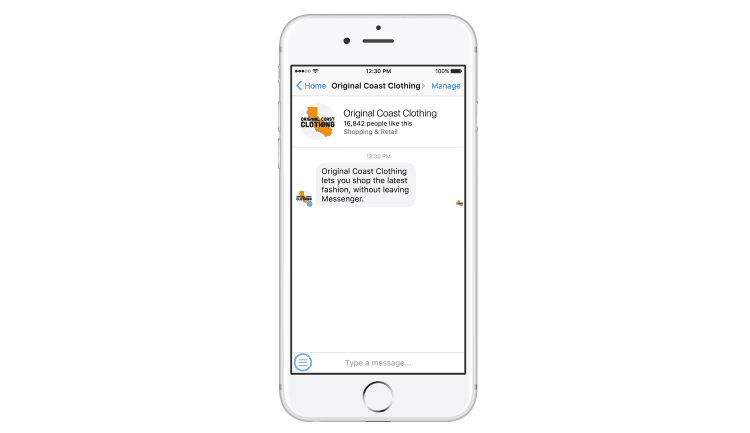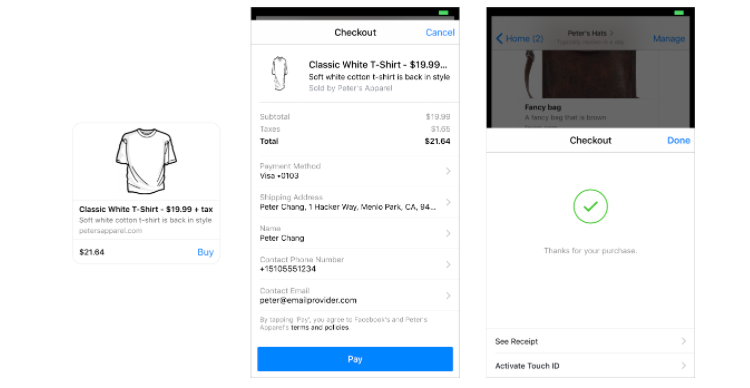Last year Facebook introduced a suite of new features for their Messenger platform including bots for messenger. Chatbots, as they have come to be known, have the ability to send and receive messages on your behalf automatically. They achieve this using some clever natural language processing (NLP) that turns regular sentences into structured data. What’s more, Chatbots can go beyond text to send buttons, image galleries, and even invoices. Chatbots are more interactive and scalable than phone calls, and much more responsive than emailing.
The implications of Chatbots for eCommerce have been huge from day one when Facebook demoed a bot built for 1800-flowers and other eCommerce stores. It didn’t take long for Shopify to release their own Chatbot app for store owners.

Source: Facebook
But after a stampede of new Chatbots hitting the market in 2016, I decided to sift through the hype and create a list of the biggest ways Chatbots can actually improve your online store today.
1. Improve Conversion Rates on Mobile
Global conversion rates for eCommerce stores on smartphones are just 1.53% compared to 4.43% for desktop websites. People are spending an increasing amount of time browsing on their phone, but still not purchasing at the same rate they do on desktops. Translating a store designed for desktop to mobile with a responsive website might not be enough to stay relevant.
So what does work on mobile? Messaging! So much so that messaging apps have quickly passed social media apps in monthly active users.

Source: Companies, Business Intelligence
Conversational commerce is a new approach to mobile eCommerce. It utilizes messaging to provide your customers with the best shopping experience by letting them discuss their needs and ask questions about your products in real time with a Chatbot.
2. Be Where Your Customer Is
Odds are, most of your customers are already using a social messaging app. In fact, you probably even have the option for them to log in to your site through their social account.
As opposed to email updates, Chatbots allow you to extend into the place where a customer naturally communicates with everyone else in their life. By reaching out where your customer already operates you reduce the friction of swapping between different channels and can encourage a personalized conversation around their order, as opposed to a generic email back-and-forth. The user will be grateful to have been handed a personal avenue to ask questions about their order specifically, and this creates the opportunity to have conversations around your brand.
While some might be (rightfully) hesitant to encroach on a user’s Facebook territory, it is important to take the more considered approach with Chatbots on social media than you would with social media overall.
Chat is a more personal space often reserved for friends. Domain.com.au have shown a good example of Chatbot notifications done right with their bot that notifies the user of weekly auctions. Much like email opt-ins, Chatbots should respond only to user-initiated conversation or action.

Source: Domain Property Group
3. Make Purchasing Frictionless
Often when talking with a customer over email or a help chat, the biggest amount of friction comes when the user is ready to purchase. Traditionally you could send them a link to an item or ideally a shopping cart, but Facebook is taking this a step further by integrating payments right into Messenger! Though the program is still in beta at the moment, using a Chatbot integrated with a payment gateway like PayPal or Stripe means you will have an automated funnel that goes from customer acquisition right through to payment. The customer can browse products, ask for help on certain topics, pay for items, and receive order follow-ups all without any interaction from the business owner or the delays associated with email.

Source: Facebook
4. Personalized Shipping Updates and Customer Service
Gone are the days of SMS links and HTML emails. The Facebook messenger platform lets you send receipts, images, button menus, and even boarding passes to customers.

Source: Shopify
This translates to a better customer experience all contained in the one message feed instead of spread out across dozens of tracking notifications and emails. The novelty and convenience of receiving detailed shipping updates in chat will encourage conversations both with and about your brand.
5. Automate and Scale Your Business
Finding ways to automate your eCommerce store is the key to sustainable growth. As tools like wit.ai make natural language processing more advanced and accessible, the automation Chatbots provide might extend beyond customer service and replace some of the tasks you might hire a virtual assistant to do. Already we are seeing smart AI marketing assistants like Kit that help you create ads and social media posts.
According to Zendesk, customers prefer the option of self-service when available. Chatbots are enabling this to go further than ever before. Repetitive tasks that cause malaise between your business and the customer (like handling returns and answering F.A.Q product questions) are increasingly being handled by virtual assistants or Chatbots. What’s more, having this tasks handled by a Chatbot lets you record, measure, and tweak its effectiveness.
The most exciting thing about Chatbots is that they are already in the wild today! It’s relatively simple to integrate them into your business to save time and improve your customer experience right now. There are tonnes of ways to get started including plug and play options like Shopify’s Messenger App. For the more adventurous there are options like Chatfuel that let you create your own from scratch and the Facebook Messenger Developer docs will give you an idea of what is possible right now. Try coding in some of your frequently asked questions, so the next time a customer reaches out to you they can get the answers they’re looking for straight away.








